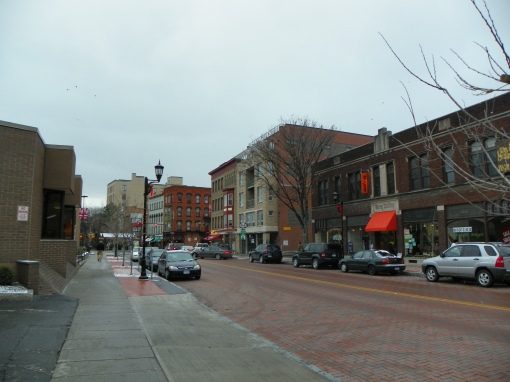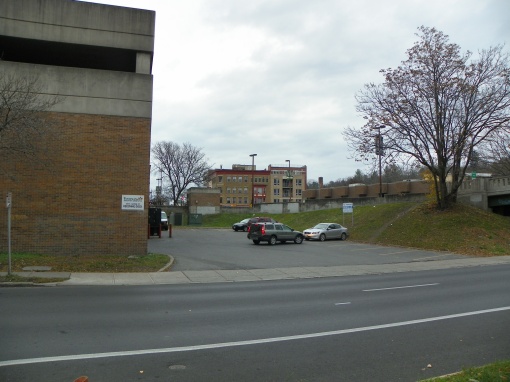It seems downtown Ithaca is in a building frenzy, even beyond sleepy upstate standards. From the Ithaca Times:
At its meeting December 20, the Ithaca Urban Renewal Agency unanimously approved the designation of Lighthouse Hotel, LLC as “a qualified and eligible sponsor” for acquiring properties at 320-324 East Martin Luther King Jr./East State Street through a negotiated sale for the purpose of an urban renewal project. The proposal by Lighthouse Hotel is to develop a $16 million, six-story Hampton Inn & Suites with 92 rooms. The project site would cover four parcels including parking lots owned by the city and the IURA, the Carey Building and 310-312 E. MLK Jr./E. State Street.
Now, this could be a little contentious. The area covered is highlighted below:
Of the four parcels, two have been parking lots for a long time, and I would not be surprised to see a garage of some sort would be a component of this project (probably above ground, given the water table…otherwise, there is a rather underutilized garage a few blocks south, if the city presses them enough and the developers are willing to play along).
Then there’s the Carey Building. The Carey Building is a two-story structure built in 1922 and named for its developer, broker Henry A. Carey. The building, with its Egyptian Art Deco accents, was designed to match the Strand Theatre to its west. The Strand Theatre, or what was the Strand, comprises the last parcel. The theatre was built in 1917, closed in 1975, and although attempts were made to save the building, it was torn down in 1993, a victim of poor maintenance. As seen in the aerial, the site is now a parking lot. For practical purposes, the Carey Building is in good structural shape, and is maintained by the locally prominent Travis Hyde properties. The Eagles Building on the SE corner is not a part of the project.
Now, I tend to not be a big fan of Hampton Inns, a middle-rung hotel chain infamous for half-assed design on the cheap. Although a slight improvement over the years, most Hamptons built in the past decade could be described as beige boxes with oversized pillasters and raised parapets. One only has to look towards big-box land for an example – The Hampton Inn “designed” by Sharma Architecture and built in 2003. Chain hotels are often the architectural equivalent of “fill-in-the-blank”, and as cheaply as possible. Still, one can hope – the average Hampton cost $6-8 million (~$60,000/room) to develop in the mid 2000s, and the budget for this project is $16 million. Hopefully, some of that will go towards something fitting for the city of gorges. In my mind’s eye, it has a more unique look, subtle or off-site parking, and incorporates the Carey Building, or at the very least its street-facing facade.
So in sum, any proposed demolition of the Carey Building might cause a lot of problems for the developer. The IURA’s decision a couple days ago only makes the developer a qualified buyer for the IURA parcel, and does not guarantee any development. And I’m sure there will be many, many meetings ahead for this one before any approvals are granted.
Update 1/9: And courtesy of the agenda comes this rendering and site plan, hosted online by “Ex-Ithacan”:


So much for preserving the Carey Building and subtle parking.
















